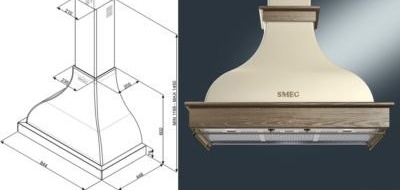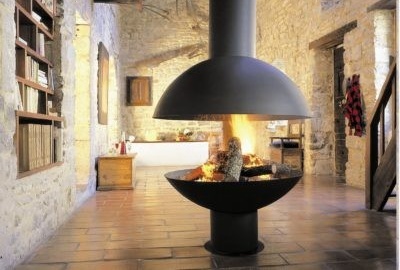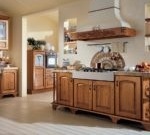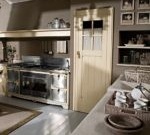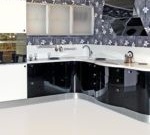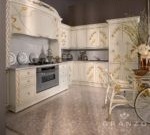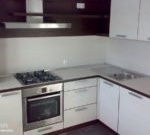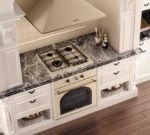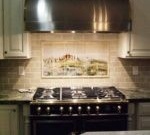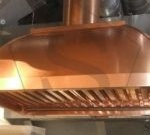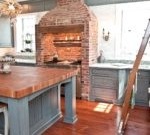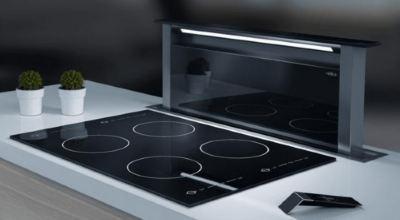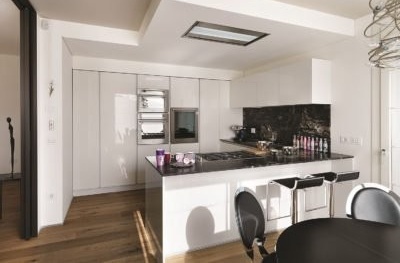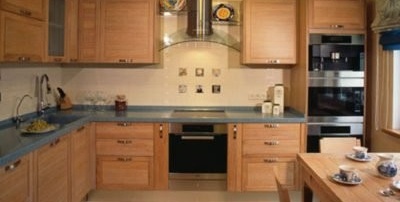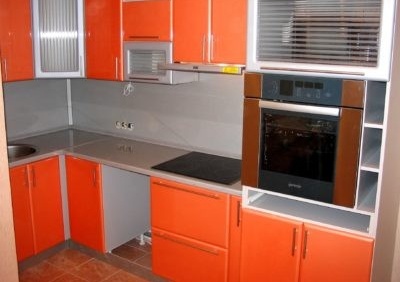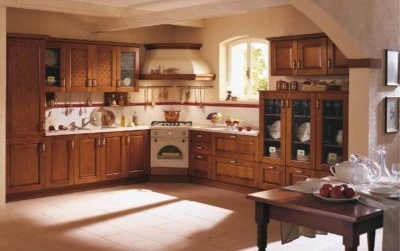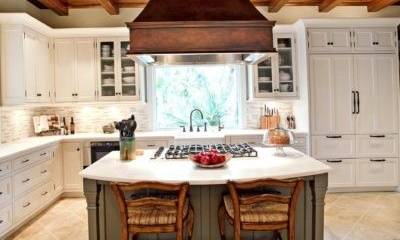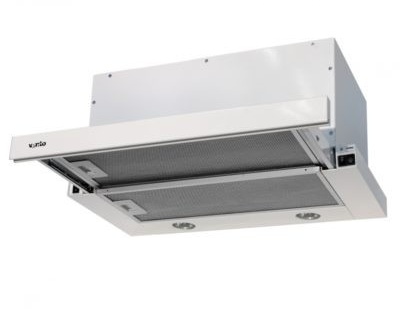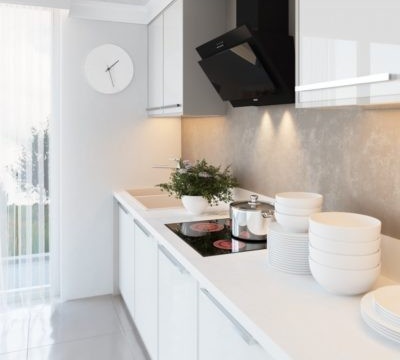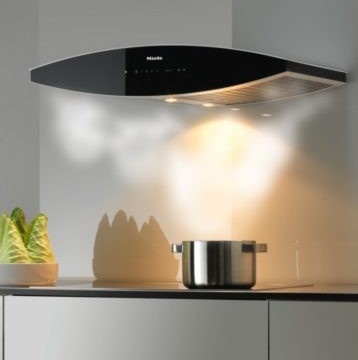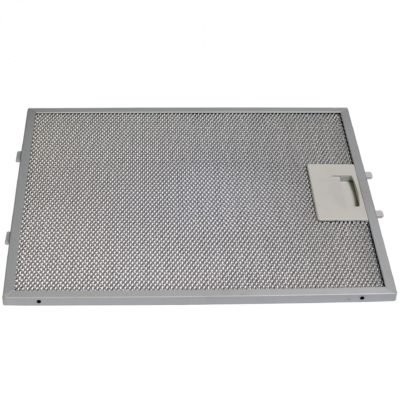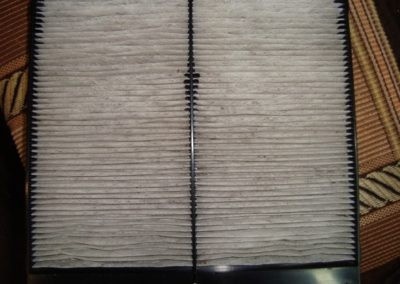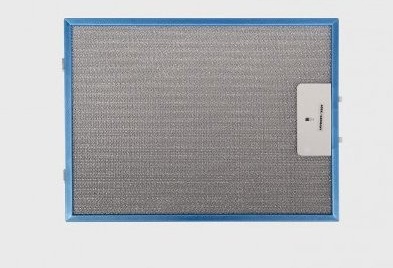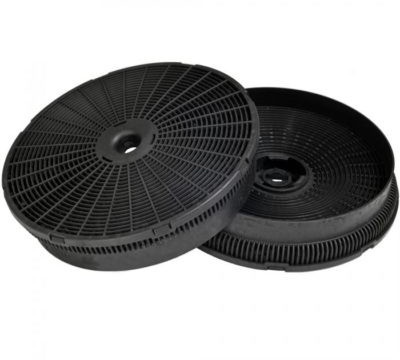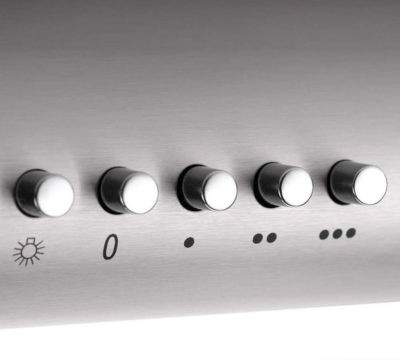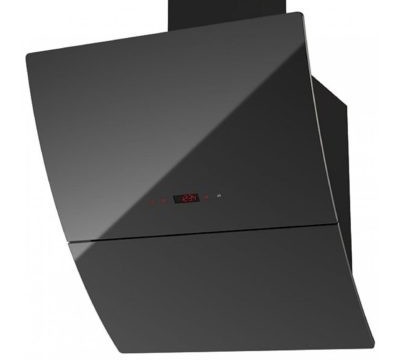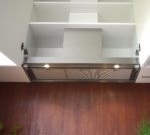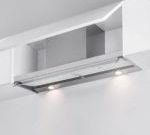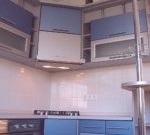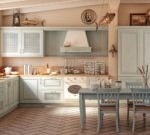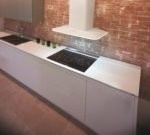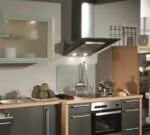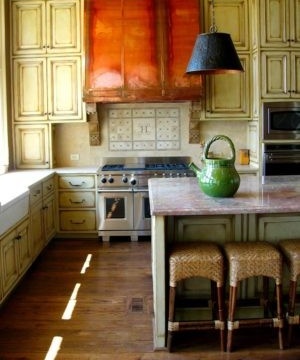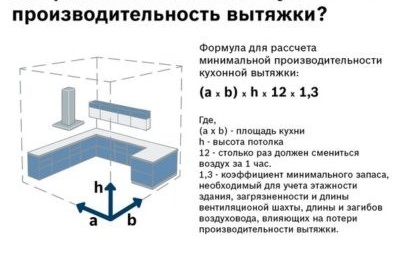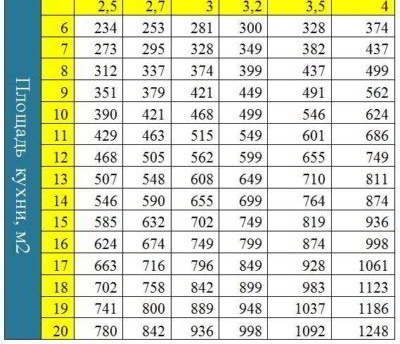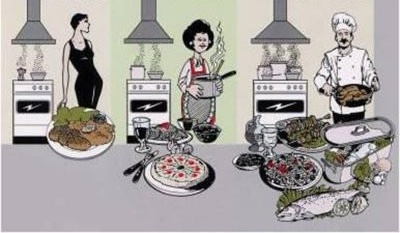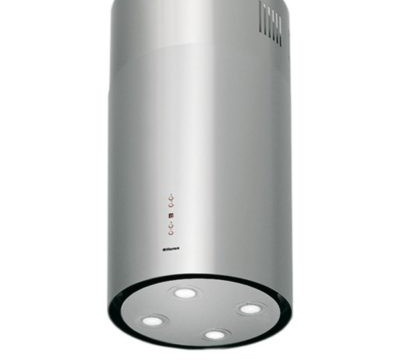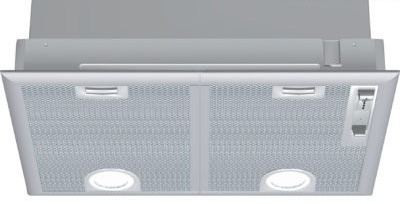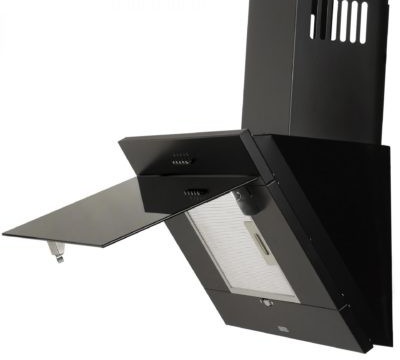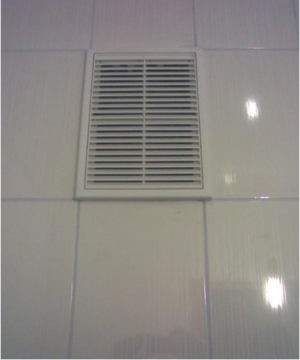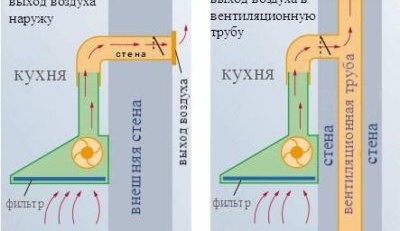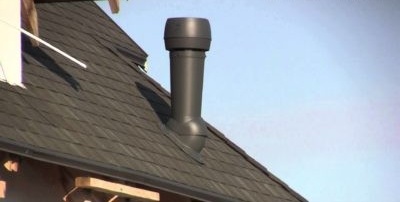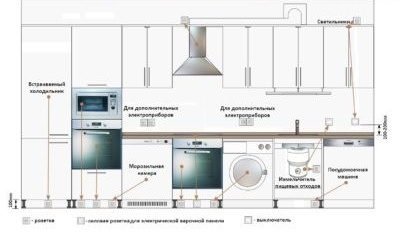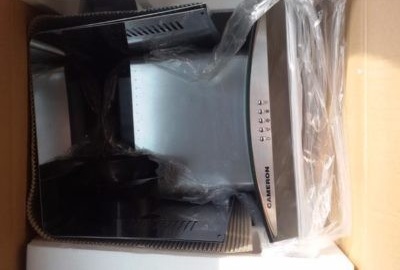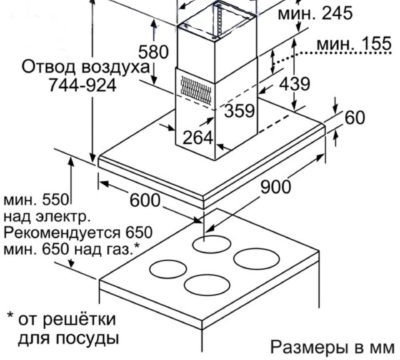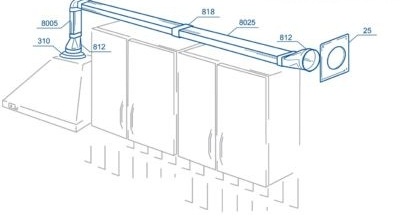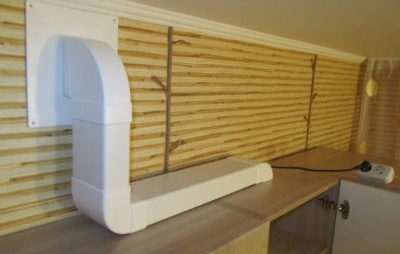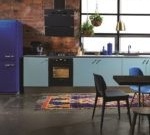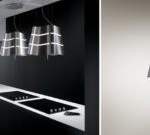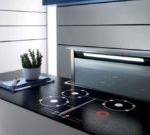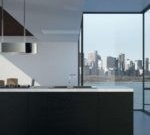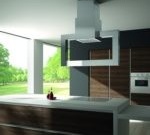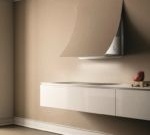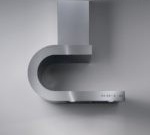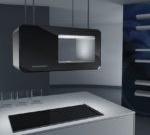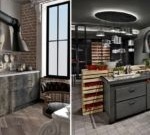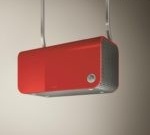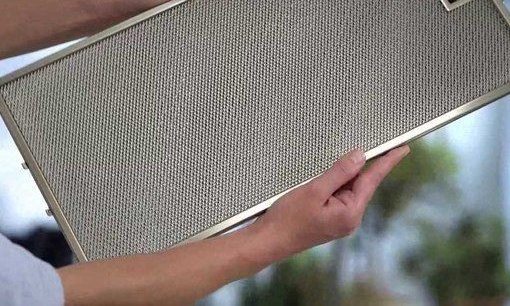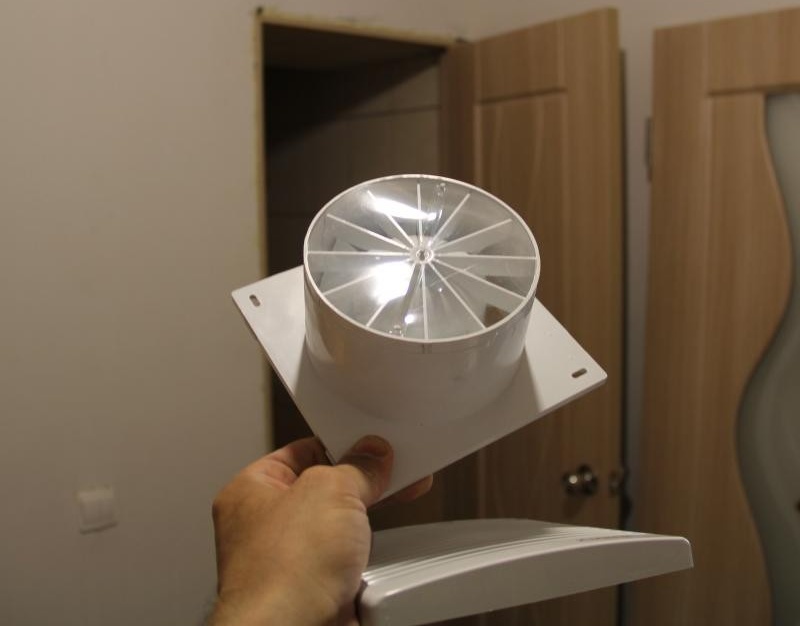Choice and self-installation of a fireplace hood for the kitchen
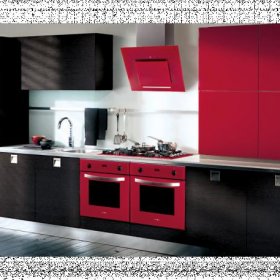
We can’t imagine our life without some home comforts. These, without a doubt, include hoods. Manufacturers respond to need. There are a huge number of types of fireplace hoods, and you can always choose what suits your kitchen in a harmonious ratio of price and quality.
Content
Why do you need hoods in the kitchen and how are they arranged
We remember the childhood or parental kitchens of our childhood: how difficult it was to scrape off the fat from the wall above the stove; persistent smell of cooking. In kitchens - especially if it is small - the concentration of harmful substances during cooking instantly becomes critical to the health of the inhabitants of the apartment.
A fireplace hood is a design or device that removes combustion products (or fumes), excess moisture and any odors from the room, lowers its temperature.
Now the cleanliness in the kitchen and the absence of odors in the apartment directly depend on the presence of the hood and how well it is selected.
Most often, this makes the hood the easiest way: being located above the source of combustion (evaporation) and connecting to the ventilation system in a high-rise building or with the ventilation outlet to the roof in your own house.
The hood in the kitchen was structurally born from a chimney, so it was called a “chimney” or “dome”. Although this is not an exact comparison: the chimney draft is created in the fireplace body itself, is laid during its construction and has a special design with a “tooth” or “chimney tooth” for settling soot, a view for cleaning soot and a shutter for changing the cross section of the pipe.
But above the modern designs of fireplaces in the center of the room of their own houses, a hood hood of the usual type should also be installed, also turning into a pipe.
A cooker hood will never look like a foreign element and will only emphasize the compositional solution of your kitchen. It can be decorated in any style - country, shabby chic, modern, art nouveau, techno, classic, made of any materials - steel, copper, brick, composites.
Examples of varieties of hoods by design (photo gallery)
- Flowing metal painted hood, decorated with wood
- Flat circulation hood integrated in furniture
- Inclined flow hood
- Built-in built-in range hood
- Flat flow hood
- Flow metal painted hood with color combined with kitchen
- Custom design solution
- Custom design solution
- The hood is combined with a stove in the form of a “stove”. Custom design solution
Views by type of construction
- Table hoods are still rare. By the type of work, they belong to the circulation (filtration), therefore, they have a low efficiency. Often they are used when they want to hide explicit kitchen appliances in the combined kitchen-dining room.
- Ceiling. These are the most inconspicuous of all hoods. Built into the ceiling in the area of the stove. This must be laid back during construction or repair, and their efficiency is also low. Meet quite rarely.
- Fireplace. This type of hood hoods, named after a fireplace portal, is still the most popular in terms of variety of design, performance, beauty and ease of installation.
Types of fireplace stove hoods
At the place of installation
- Wall mounted. They are mounted directly on the wall above the slab installed in the center of the wall. The most common. They are divided into built-in (visually closed by a cabinet) and hoods in a separate casing.
- Corner They are mounted directly on the wall above the corner plate. Their configuration is more complicated, and there are fewer options available for selection.
- Recessed. They do not have a casing and are built above the stove in a kitchen cabinet that hides the ventilation pipe. The choice of such an extract is always made at the stage of designing a kitchen and buying kitchen furniture.
- Island. If the stove according to the project is located in the center of the kitchen, it needs an island hood. In your own home, installing an island kitchen hood is easier: during construction, a separate chimney with a pipe is laid. The apartment will have to install a pipe connected to the ventilation system from an extract from the center of the kitchen.
- Retractable. This is one of the varieties of circulation hoods. The sliding panel at the switched off hood is hidden in the housing, which is convenient for small kitchens; this saves space, but they are usually very thin.
- Inclined. This is a type of wall-mounted flow hoods, they are more modern and more effective than horizontal ones, but, as a rule, they are much more expensive.
According to the principle of work
- Circulating (absorbing). The principle of recirculation is used: the air does not go outside the premises into the environment, but is filtered. Sometimes these hoods imitate a full range hood and have a decorative pipe, and sometimes they are simply a flat design. They are not connected to the ventilation system, they do not need a duct. This means that their installation is extremely simple, and the kitchen will not be disfigured by excess corrugated hoses and pipes. They work great in houses of long years of construction with a weak or tightly clogged ventilation system. In addition, they are much cheaper than flow-through. But these hoods are very ineffective.Carbon or acrylic filters remove odors and clean the air. These filters are not cheap, and must be replaced once every six months, which translates into expensive maintenance. In addition, such hoods are the noisiest of all. Filters, when air passes through them, create excess resistance, and performance decreases. The power loss of the circulation hoods when passing through the filter reaches 40%.
- Flowing (evacuating) hoods. Remove polluted and hot air outside the apartment in various ways. Very effective.
Most often, expensive flow hoods have both modes.
By filter system
- Grease filter metal - aluminum or steel, it is a frame with a metal shaped foil. The good thing is that reusable is easy to clean in the dishwasher or manually. It is used in all types of hoods.
- Cassette grease filter - a cartridge with filter material, more often it is a synthetic winterizer. When it gets dirty, the cassette is simply changed. It is used in circulation hoods.
- Acrylic filter is designed to protect the exhaust motor from grease. It is reusable, once a month to be washed in a warm soapy solution. It is used in expensive flow hoods.
- Activated carbon charcoal filter not only purifies the air, but also neutralizes kitchen odors. It is used in all types of hoods, but in flow hoods - only in expensive models.
By the method of controlling the motor and lighting
- Mechanical control: buttons or sliders (slider). Buttons are a traditional convenient and reliable option. They are usually located on the front surface.
- Electronic control: display with sensors. Beautiful, functional and modern, easy to care for and remove fat. Convenient options are often available, for example, auto-on when the level of pollution increases, a timer for turning on and off at a given time. But electronic control often breaks due to the usual power surges; replacement is very expensive.
Different types of hoods (photo gallery)
- She does not have her casing
- With the door closed, completely invisible
- Designed with kitchen furniture
- Can be used as a shelf for souvenirs.
- Minimalist hood in a white kitchen
- It is good because it does not visually clutter up the kitchen
Video: how to choose the best range hood for your kitchen?
The nuances of choice
In size
The area of the hood hood is chosen equal to or greater than the surface of the heating plate. With a slab of non-standard sizes, the choice of hood is complicated. Sometimes it’s easier to order its manufacture.
By power and performance
Performance shows how many cubic meters of air per hour a working hood will bring to the ventilation shaft using an air duct. Or filters it and returns to the kitchen. It is on the conformity of the performance of your hood to the size of your kitchen that the cleanliness and air condition depend.
If you dream of a flow hood, you need to consider the size of the kitchen and the shape of the duct.
Kitchen volume - length times height and width. From it you need to subtract the approximate amount of furniture. The resulting figure must be multiplied once again by 12, because the air according to sanitary standards should be updated 12 times per hour, and by a safety factor of 1, 3.
There is a table in which, however, does not take into account the volume of kitchen furniture. Although this is not critical. Example: for kitchen 6 m2 with a ceiling height of 3 m, a weak hood with a capacity of 281 m is suitable3/hour.
Consider the estimated distance between the hood and the stove - between 65 and 85 centimeters. But if the inhabitants of the house are tall people, then you need to strengthen the hood higher so as not to bang your heads on it. Or you have a gas stove, and the hood must also be hung higher so that open fire and high temperature do not follow the body. The higher the hood, the greater should be its performance.
In old houses, the ventilation system is usually clogged with centuries-old pollution. If you use a flow hood there, then its performance may not matter. The motor will idle and very noisy. In this case, it is better to make an air duct through the wall to the outside (in a high-rise building it is not always possible to obtain permission for this) or apply a circulation hood.
If you cook a lot, varied and with lots of frying for your family, and besides in a small kitchen, then you will need a powerful hood. And vice versa.
Performance is determined by power. The data sheet indicates the power of a particular hood, and the corresponding performance.
Noise level
Any hood with power supply is noisy, and the more powerful the hood, the greater the noise. You need to choose a modification that harmoniously combines acceptable performance and noise level for you. Some hoods have a special housing design: the outer and inner casing have a soundproof gasket.
The strength of the noise of the hood when buying is not determined. Need to look at the data sheet. It indicates the noise level in decibels. Absolutely comfortable noise level - 35 decibels (whispering). Quite acceptable - 50 decibels. 70 and more - completely uncomfortable, especially in a small kitchen.
Video: On the intricacies and pitfalls of choosing hoods when buying
TOP 5 best models of 2017
PERFELLI TL 6102 i
- Production - Poland
- Series - ORZO Design Line
- Color - Stainless Steel
- Type of hood - telescopic
- Mounting Type - Built in Hanging Cabinet
- Design - with pull-out panel
- Principle of Operation - Retraction / Recirculation
- Built-in width - 60 cm
- Power Consumption - 150 W
- Productivity - 550 m3 / h
- Management - mechanical push-button
- Noise Level - 53 dB
- Grease filter, installation of an active filter possible
- Weight - 7 kg.
Simple, inexpensive, recessed hood with pull-out panel. The set of features is minimal. A good compromise between price and quality. An interesting solution. Fastens easily if the appropriate size of the kitchen cabinet is provided.
Given not the highest cost and compactness, you can forgive the shortcomings. Pluses: Like the simplicity of design and compact size. I believe that such a technique should simply perform its functions efficiently and not fly into itself too much attention. In the mounted form, the hoods are almost imperceptible. The idea of an extra pull-out panel seems like a smart solution. I put forward an additional panel only in cases where all four burners are occupied, in other cases this is not particularly required. The hood's working efficiency is enough for everyday needs. Steam leaves almost in full, however, the same way as smells. High-quality implemented backlight function. The light is bright and precisely directed, it can even be used as the main one. In operation, the hood is simple, the controls are located at a convenient point, the buttons are gently pressed. Disadvantages: Only two engine speeds are realized. I have the impression that some average speed is lacking here, since the first is clearly not enough, and the second creates too much noise. Something average would be just perfect.
HANSA OWC 4778 IH
- Production - Germany
- Type of installation - fireplace island
- Color - Stainless Steel
- Design - cylinder
- Principle of Operation - Retraction / Recirculation
- Width (diameter) - 38 cm
- Power Consumption - 280 W
- Productivity - 900 m3 / h
- Management - electronic touch
- Noise Level - 53 dB
- Options - auto power on by odor sensor, timer, filter pollution indicator
A modern and stylish range hood is a real decoration of the kitchen. Its main plus: the ability to install both against the wall, and over a freestanding stove in the center. Numerous options affect cost.
The biggest plus for me is the front control. That is, turning on the backlight without extending the front panel and the remoteness of the control from pollution (steam, grease). Metal filter (can be washed in a dishwasher), three speeds for every taste! Appearance - looks great. Made soundly. Serves true two years. Well, what is noisy, so they are probably all like that. All scold them for it.
PYRAMIDA WH 22–60
- Production - China
- Mounting Type - Pendant
- Color - Stainless Steel
- Principle of Operation - Retraction / Recirculation
- Built-in width - 60 cm
- Power Consumption - 120 W
- Productivity - 320 m3 / h
- Management - mechanical push-button
- Noise Level - 50 dB
- Grease filter, installation of an active filter possible
A beautiful, inexpensive hood with convenient controls. You can add a charcoal filter. Disadvantages: too noisy, it is difficult to wash the glass visor, which is constantly contaminated with fat.
Advantages: the design is as simple as possible, but at the same time the hood does not look cheap. I took a white one, as it fits the rest of the technique. Management is as simple as possible - simple little buttons. I think this is the best option possible. Regarding the work. In general, I am quite pleased with the results of this hood. Smells go away without a problem. All the vapors that occur during the cooking process fall precisely in the hood, so the air always remains fresh. The store recommended installing an additional carbon filter, but so far I do not see the point. And without this, the hood does its job well. Disadvantages: I do not like the way the backlight is made. The light from them is yellow and weak. But in general, the hood is not bad, it's worth the money. It looks simple, but attractive, and works flawlessly. I didn’t intentionally buy an expensive hood, since there is practically no difference between expensive and budget models. I took something in order not to fall for a budget Chinese who would break in the first couple of months.
BOSCH DHL 545 S
- Production - Germany
- Color - Stainless Steel
- Mounting Type - Built in Hanging Cabinet
- Principle of Operation - Retraction / Recirculation
- Built-in width - 60 cm
- Power Consumption - 380 W
- Productivity - 500 m3 / h
- Management - mechanical slider
- Noise Level - 62 dB
- Grease filter
Powerful, but compact and quiet hood with two bright halogen lamps at an average price in the market.
Great model. Use experience - several months. Advantages: very quiet and very powerful, pleasant lighting and control knob. Disadvantages: not identified. Comment: attention !!! Requires 40 cm cabinet depth, does not fit into a standard !!!
ELEYUS LANA 700 60 BL
- Production - Ukraine
- Material - metal, glass
- Type of hood - inclined
- Mounting Type - Fireplace Wall
- Principle of Operation - Retraction / Recirculation
- Built-in width - 60 cm
- Power Consumption - 220 W
- Productivity - 750 m3 / h
- Management - mechanical push-button
- Noise Level - 50 dB
- Grease filter - aluminum panel
- Option - Anti-Return Valve
- Weight - 12 kg.
This is one of the best models in terms of price, quality and design. Has halogen lighting with two 35 W lamps.
Great model, really liked it.Advantages: the hood is simple, straight, strict lines, generally beautiful in appearance. There is a backlight, soft light of two halogen bulbs, it looks beautiful. There are no special complaints about the work. Convenient controls, just buttons that are interestingly invented and add beauty to the design. Only three speeds, we usually keep on the first, sometimes with a smell I can turn on the second. This is enough, since the power is normal at the hood, and we do not have any special pollution. Likewise, without looking easily, you can turn it off or turn on / off the backlight. Definitely, after the active use of the hood, I can note that the air has become cleaner, there are no smells of the kitchen in the apartment, the furniture has become easier to wash, as there are less greasy spots. The hood is inexpensive, however it works - I like it. Disadvantages: no complaints about the work.
We have chosen the model most suitable for us. Now you need to install it.
How to install a fireplace hood yourself
We will need:
- Building level
- Roulette
- Drill (punch)
- Building level or plumb
- Pencil
- Screwdriver Set
- Screws, dowel nails
Adjustment of the ventilation system
This is only necessary for flow hoods. It so happens that there are two ventilation outputs. Then an air duct is mounted to one of them, and the other remains for ventilation of the kitchen. If there is only one outlet, then you need to provide a hole in the duct with a mesh closer to the wall.
If possible (for example, in your own house), it is advisable to make a hole in the wall directly into the street.
Outside, you need to mount a vertical pipe of the same diameter with a fungus or device that prevents the penetration of water.
Then the ventilation duct needs to be added to the design of the check valve to prevent the entry of cold air into the house. To protect against mice and insects, a fine mesh is built into the ventilation duct at the outlet.
Electrical installation
The hood is a powerful appliance that operates at very high temperatures and impurities in the air, which can lead to a short circuit. Therefore, it must only be connected to a grounded power supply via a junction box or an appropriate outlet. If there is no grounding, it must be carried out from the home electric meter yourself. A three-pin exhaust outlet with an earth terminal can be installed below the cabinet line, but in no case next to a stove or sink. The best option is above the cabinets next to the hood.
Determine the height of attachment
Unpack the purchased hood and check for completeness. Must be present: for flow hoods - its own air duct-pipe with accessories (adapter flange with check valve), a bracket for attaching the housing, a set of hardware.
We measure and draw with a pencil the bottom line of the hood. The hood should not be located lower than 50 cm from the stove - melting of the body and fire are possible. The optimal height is 60 cm; but if the gas stove, then - 75 cm. The installation height also depends on the width of the hood. If it is narrow, then for better air capture it is necessary to hang it as low as possible.
If the duct pipe rests against the ceiling, and the hood is scheduled to be hung extremely low and it is no longer possible to lower it, you need to cut the bottom of the pipe.
Installation
- We drill holes for the dowel-nails.
- Wall and corner hoods are mounted on supports. We mount the fastening system on the wall using dowels and nails.
- We attach a hood to the wall using a level and a plumb line.
Duct installation
We outline the passage of the duct from the hood to the ventilation hole.
The prepared additional duct (more often it is still a corrugated pipe) is connected to the transitional flange of the exhaust pipe. The connection is sealed - sealant or otherwise.
The other end of the duct fits to the opening of the ventilation shaft. Here it can be fixed with foam, which after hardening is cut off with a knife.
The air duct on the wall must be well fixed, and it is desirable (although not necessary) to sheathe it with sound insulation.
Important: you should know that every rotation of the duct and the use of a corrugated pipe (despite the ease of bending it) greatly reduces the performance of the hood.
We connect the hood to the mains. Enjoy the clean air in your favorite kitchen.
Video: step-by-step hood installation
Operational Features
The hood is quickly and very dirty. Dirt and grease must be removed frequently, as they can cause a fire.
Outside, the hood is washed with conventional detergents, in the case of a steel casing - with stainless steel products. Inside this is not enough. It is necessary to rinse and change the filters. If there are a lot of filters in the kit, it is necessary to completely dry them before reinstalling; Strong condensation may form inside, which will cause a short circuit.
Varieties of modern design hoods (photo gallery)
- The evolution of this technique has moved to inclined hoods, which are now considered more efficient.
- It is distinguished by its breathtaking design and looks more like a chandelier or pendant lamp; works through the built-in filter
- Very minimalistic option
- It is distinguished by its breathtaking design and looks more like a chandelier or pendant lamp; works through the built-in filter
- Just very pretty
- Design solution
- Despite the avant-garde look, she fully copes with her tasks.
- They also began to take unusual shapes and, in addition to increased engine thrust, sensors, air pollution sensors and remote controls were added to them
- Simple wall hoods have almost been abandoned
- It is distinguished by its breathtaking design and looks more like a chandelier or pendant lamp; works through the built-in filter
With a huge variety of manufacturers, an unimaginable choice of models for every taste and budget, the ease of installation of modern hoods gives us the opportunity to make our life in the house much more comfortable and the air cleaner.
